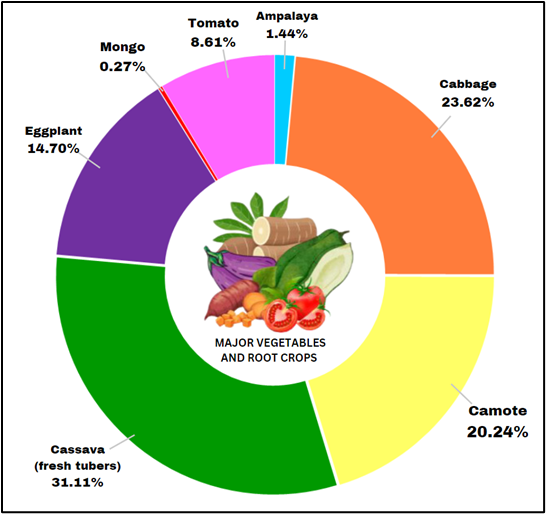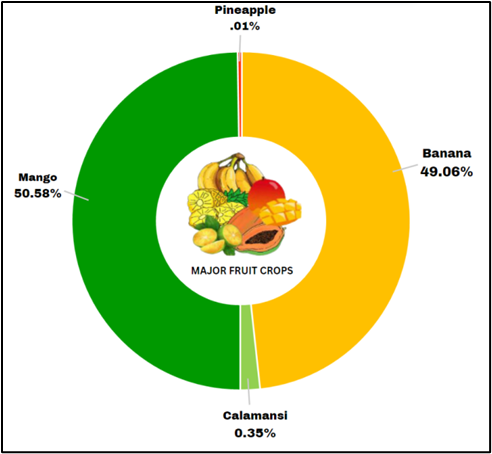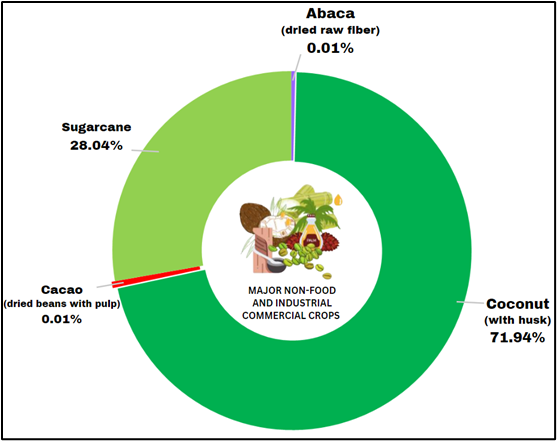VOLUME OF PRODUCTION BY COMMODITY GROUP
The total production of Other Crops in the Province of Cebu was reported at 131,971.47 metric tons in first semester of 2024. Compared to the same period of 2023, the province had a production decrease of 37.43% or from 210,906.86 metric tons, it dropped by 78,935.40 metric tons. Fruit Crops and Non-Food and Industrial Commercial Crops (NFICCs) decreased by 9.47% and 59.49% respectively on the same reference period. On the other hand, Vegetables and Root Crops (VRC) showed a slight increase of 1.05% in first semester of 2024 among the other commodity groups.
Table 1. Volume of Production of Other Crops by Commodity Group, Province of Cebu
1st Semester 2023 and 1st Semester 2024

Source: Philippine Statistics Authority, Crops Production Survey (CrPS)

*Note: Details may not add up due to rounding.
Figure 1. Crops Volume Production in Percent Share, Province of Cebu, 1st Semester 2024
Source: Philippine Statistics Authority, Crops Production Survey (CrPS)
Fruit crops shared the biggest contribution at 38.78% or 51,184.45 metric tons. It was followed by Non-Food and Industrial Crops (NFICCs) with a production share of 38.13% or 50,323.80 metric tons. Meanwhile, 23.08% or 30,463.22 metric tons were produced by Vegetables and Root Crops (VRC). (Figure 1)
MAJOR VEGETABLES AND ROOT CROPS (VRC)
The total production of major vegetables and root crops recorded at 18,246.75 metric tons, with an increase of 9.73% during first semester of 2024. Ampalaya fruit experienced the largest drop in production by 34.72% while Camote, Cassava (fresh tubers), Eggplant, Mongo and Tomato registered declines of 4.58%, 3.49%, 11.35%, 12.96% and 5.98%, respectively. In contrast, Cabbage showed a significant production increase of 150.67% during the same period. (Table 2)
Table 2. Volume of Production of Major Vegetables and Root Crops, Province of Cebu 1st Semester 2023 and 1st Semester 2024

Source: Philippine Statistics Authority, Crops Production Survey (CrPS)

*Note: Details may not add up due to rounding.
Figure 2. Major Vegetables and Root Crops Volume Production in Percent Share, Province of Cebu, 1st Semester 2024
Source: Philippine Statistics Authority, Crops Production Survey (CrPS)
In the first semester of 2024, Cassava (fresh tubers) made the largest contribution to the total production of major vegetables and root crops, comprising 31.11% or 5,677.33 metric tons. Cabbage contributed 23.62%, followed by Camote with 20.24%, Eggplant at 14.70%, Tomato at 8.61%, Ampalaya at 1.44%, and Mongo with 0.27% of the overall production in the province during this period. (Figure 2)
MAJOR FRUIT CROPS
Major fruit crop production declined by 9.39% with 48,779.57 metric tons in first semester of 2024 from 53,831.96 metric tons in the same period last year. Banana, Calamansi, Mango and Pineapple recorded negative growth rates of 14.07%, 19.45%, 4.21%, and 59.04%, respectively. (Table 3)
Table 3. Volume of Production of Major Fruit Crops, Province of Cebu 1st Semester 2023 and 1st Semester 2024

Source: Philippine Statistics Authority, Crops Production Survey (CrPS)

*Note: Details may not add up due to rounding.
Figure 3. Major Fruit Crops Volume Production in Percent Share, Province of Cebu, 1st Semester 2024
Source: Philippine Statistics Authority, Crops Production Survey (CrPS)
Mango comprised 50.58% or 24,671.48 metric tons of the total production of major fruit crops in first semester 2024. It was followed by Banana, which contributed 49.06% or 23,929.13 metric tons; Calamansi, with 0.35% or 172.12 metric tons; while Pineapple shared .01% or 6.84 metric tons to the total production of major fruit crops in the Province of Cebu during the period. (Figure 3)
MAJOR NON-FOOD AND INDUSTRIAL COMMERCIAL CROPS (NFICCs)
In the first semester of 2024, the production of major non-food and industrial commercial crops was recorded at 45,236.93 metric tons, showing a significant decline of 60.48%. Abaca (dried raw fiber) had a considerable increase of 49.77%, while Cacao (dried beans with pulp) also experienced a slight increase of 0.19%. On the contrary, Coconut (with husk) had a negative growth rate of 17.70% while Sugarcane had a remarkable decrease of 83.07%. (Table 4)
Table 4. Volume of Production of Major Non-Food and Industrial Commercial Crops, Province of Cebu 1st Semester 2023 and 1st Semester 2024

Source: Philippine Statistics Authority, Crops Production Survey (CrPS)

*Note: Details may not add up due to rounding.
Figure 4. Major Non-Food and Industrial Commercial Crops Volume Production in Percent Share, Province of Cebu, 1st Semester 2024
Source: Philippine Statistics Authority, Crops Production Survey (CrPS)
Among the major NFICCs, Coconut (with husk) contributed 32,543.32 metric tons, and share 71.94% of the total production of major NFICCs in the first semester 2024. Followed by Sugarcane, which contributed 28.04% or 12,685.13 metric tons; Abaca (dried raw fiber) with 0.01% or 3.31 metric tons while Cacao (dried beans with pulp) also comprised 0.01% or 5.17 metric tons of the province’s total major NFICCs production during the same period. (Figure 4)
TECHNICAL NOTES
Crops Production Survey (CrPS) is a quarterly survey which aims to generate basic production statistics for crops other than palay and corn at the national and sub-national levels. Twenty major crops under the Other Crops sub-sector are highlighted in the Value of Production in Philippine Agriculture and Fisheries. The CrPS covers more than 280 crops sub-classified under three commodity groupings, namely: (1) Non-Food and Industrial Crops, (2) Fruit Crops, and (3) Vegetables and Root Crops.
Vegetable Crops are mostly temporary crops which are either classified agronomically as such or based on purpose for which they are used.
Root Crops are well developed underground edible roots. They are classified into tubers and roots.
Fruit Crops a perennial, edible crop where the economic product is the true botanical fruit or is derived therefrom.
Non-Food Crops are crops other than those used for food consumption. These are crops grown for their aesthetic values such as ornamental plants and cut-flowers. These also include agriculture-derived products such as rice and coconut leaves.
Industrial Crops are crops that are used as inputs to other industries.
Major Crops refer to the top 22 crops, which collectively account for almost 95 percent of the total crop production. These include palay, corn, coconut, sugarcane, banana, pineapple, coffee, mango, tobacco, abaca, potato, mongo, onion, cassava, sweet potato, tomato, ampalaya fruit, cabbage, eggplant, calamansi, rubber, and cacao.
Crop Production refers to the quantity produced and actually harvested for a particular crop during the reference period. It includes those harvested but damaged, stolen, given away consumed, given as harvester’s and thresher’s shares, reserved, etc. It excludes those produced but not harvested due to low price, lack of demand, force majeure, or fortuitous events, etc.
Metric ton - refers to a unit that is being used which is equal to 1,000 kilograms.
Approved by:
(SGD)
MELCHOR B. BAUTISTA
Chief Statistical Specialist
RHS/MJDG

